There are several milestones in a car’s complete restoration, and the best ones are usually on the “downhill side” – the reassembly where things start to look like a car again and the light at the end of the tunnel begins to shine. The freshly painted drivetrain, ready for re-installation, must certainly be one of those milestones, and we passed that point a few days ago.
The Austin A90 engine has seldom been singled out as one of the more exciting engines, either cosmetically or performance-wise, but to a true Healey enthusiast, it has a unique inner and outer beauty. Therefore, presented here for your viewing pleasure, is the drivetrain of the RHD BN2 Le Mans project that continues to make good progress.
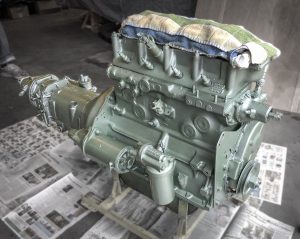
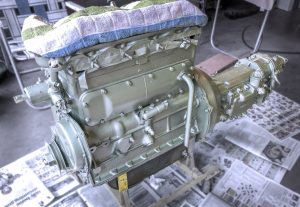
1955 was a very good year and in some ways, now 65 years later, it looks even better.
For the benefit of any Healey owners reading this who do not get the monthly 40- or 48-page magazine Healey Marque (48 pages in this issue), here’s a look at the October issue cover and a list of features:
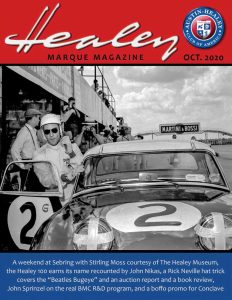
And here’s a clipping from the Table of Contents:
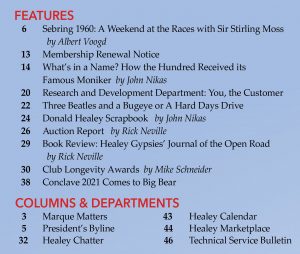
Visit healeyclub.org to join the club and receive the magazine every month. You are interested in Healey marque cars, aren’t you?
In the off chance that any Austin-Healey Club of Oregon members are reading my blog, it’s time to prepare for the bi-annual election of officers for the 2021-2022 term. A nominating committee has been formed and anyone interested in standing for one of the club offices is encouraged to contact Mark Schneider, chair of the committee, at marksbj8@gmail.com.
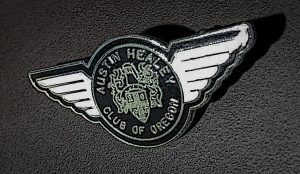
As the incumbent club president, elected less than a year ago to fill the then-vacant position, I am willing to stay on for the next term, but I’m also delighted to stand aside if some other member would like to bring their vision to the leadership of the club. After all, I have failed miserably to find a cure or vaccine for the pandemic, I have no new ideas for improvements in preventing and fighting the wildfires consuming large swaths of the state, and don’t get me started on the rioting and arson.
On the positive side, with so little club activity, expenses for the year have been minimal.
I’ll also readily confess that I have failed to hold the bylaws-required number of meetings, and so if you can’t come up with someone better for the job, let’s face it – you’re not really trying.
The original jack for the RHD BN2 Le Mans has been found and reunited with the car! Recall that this car was purchased from an estate and the recently deceased long-term owner had squirreled away various parts and pieces here, there, and everywhere. The man helping to dispose of his cars has been very helpful in continuing to go through the attic, basement, and outbuildings and notify us when he found something that he felt might go with this Healey. We had asked specifically about a jack, and I subsequently sent him some photos to help him identify the jack that goes with this Healey. He recently sent this photo to ask if it’s the right one for the car:
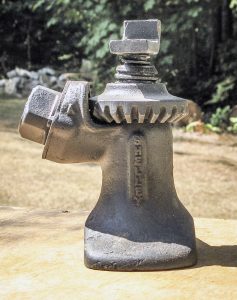
It was a medium-sized thrill for this item to have been found, and after confirming that it is indeed correct for the car, he mailed it and it arrived today. Here are a couple more pix:
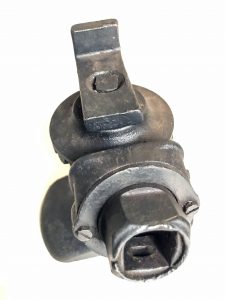
And this pic shows the all-important date code of 55 for this BN2 finished on November 1, 1955:
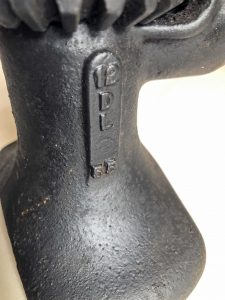
Yes, some people are just easily thrilled I suppose. But like so many pleasures in life, it’s the little things.
Well, the RHD BN2 chassis is now at the body/paint shop for rust repair and paint. We finished stripping it in about four three-day stints, which I thought was pretty good. Here’s the scene as we departed Kent’s place for the shop in Eugene, about 175 miles away.
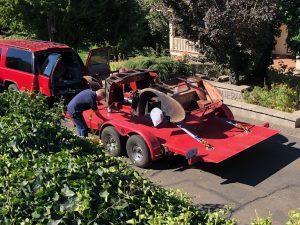
Why did we select a shop so far away? Easy. This is the shop that was used by our dear departed friend John Wilson, and is still used by his son Robert – now running John’s Healey restoration business, Healey Lane in Marcola, Oregon. The owner of the body shop stated that he has done over 50 Healeys, and so he knows the cars and the parts sources. That’s definitely worth a lot.
The shop owner estimated that we could potentially get the car back by Halloween, so in the meantime we have already begun the process of cleaning and prepping all the stuff we removed, getting it ready for reinstallation. Then the chassis goes back to the shop for fitting the outer body, and so it’s looking quite possible that we’ll have it done in the spring. It will be Carmine Red with a black interior, as original, and with the car’s documented provenance, we’re anticipating that the result will be a really spectacular historical example.
Recall that the shroud supports in the engine compartment on a 100 are traps for anything dropped into them. There’s no outlet, and over the decades these tend to accumulate a certain number of hardware items and other things that get dropped while working on the car.
Well, as Kent and I were finishing up stripping the chassis of the RHD BN2 for the body and paint shop, we decided to check these infamous vaults, and with the aid of a pick-up tool Kent extracted a small and very corroded spanner.
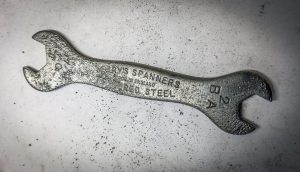
I cleaned it on a wire wheel and was surprised to find so many markings. Before cleaning it, it looked like an ultra-cheap, stamped tool, but in fact it is labeled with all kinds of information:
TERRY’S SPANNERS
MADE IN ENGLAND
TEMPERED STEEL
And the ends are marked with the sizes: 0 BA and 2 BA.
I had never heard of Terry’s Spanners – a contemporary competitor of Superslim and King Dick? – and we wondered when it was lost into the deep recesses of this car.
Since it was made in England it seems most likely that it has been in there since at least 1962 when the car was shipped to the USA. Was it dropped on the assembly line in Longbridge? Was it dropped during servicing while the car was owned in England 1956-1962? Perhaps the first owner “deposited” it there. By the way, it was on the distributor side of the engine, so it wasn’t likely lost while working on the carbs.
In any case, we’ll never know, but at least it satisfied my hope that we’d find some such artifact in the disassembly process. I had been hoping to find a UK coin – a penny would do – but this is actually more interesting and will become part of the tool kit.
I must remember to report these findings to the Concours Committee.
… it smells like victory. And also restoration. A restoration has its own special smell.
Work continues to strip the RHD BN2 Le Mans for the body-paint shop. We’re taking it down to every last nut, bolt, screw and clip, and any other loose parts that we can pry off the chassis.
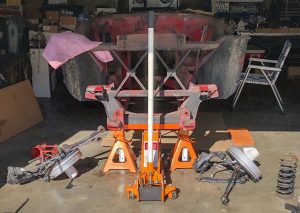
Once we made the decision to go this far, we thought we’d might as well do it to concours standards, and we’re finding lots of original parts and hardware as we go – we’re undoubtedly the first ones to remove these things since it was assembled at Longbridge 65 years ago – and we’re following the sage advice of our departed and much missed friend, Rich Chrysler.
Rich told the story of someone who once commissioned him to restore their Healey, but added, “I don’t need it restored concours.” I suppose the guy thought that meant he’d pay less, but Rich’s response was classic and is burned into my memory: “OK, what didn’t you want done right?”
We’ve decided to do everything right. Should be quite a specimen when we’re finished. Thanks for the inspiration Rich.
You probably remember the iconic scene from the movie, “Crocodile Dundee,” where the protagonist and his girlfriend are confronted by a thug with a switchblade, demanding his wallet. Dundee’s response, “That’s not a knife,” as he unsheathes his own, much, much larger knife and proclaims, “THAT’s a knife!” came to mind as we were pulling the engine of the RHD BN2 Le Mans.
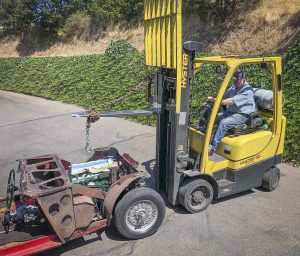
Now I’ll admit it doesn’t hurt anything to own a large fruit-packing operation just down the road a bit, as Kent does. As you see, Kent borrowed the forklift from the packing house.
The ability to lift 5,000 pounds to a height of 20 feet was more than we needed, but it’s always good to have some capability in reserve.
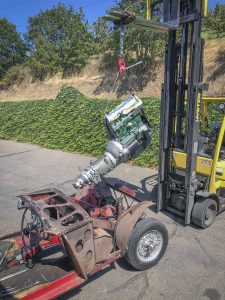
Like admiring a sport fisherman’s trophy still on the hook, we briefly basked in the glow of victory before resuming the less glamorous task of removing every nut, bolt and screw from the crusty chassis. However, thanks to saving all that energy in the engine-pulling episode, we’re making great progress.
Three more days on task are planned for this weekend, and removing hardware that was installed at Longbridge in 1955 has a certain step-back-in-time quality. You almost begin to think you know the men who assembled the car, and in a certain way, you do.
Visiting Kent Lambert’s secret storage facility (not in Hood River!) last week, I was admiring the garage art and particularly noticed this rare, possibly only-one-remaining, showroom poster and was really impressed with the clean, bold design.
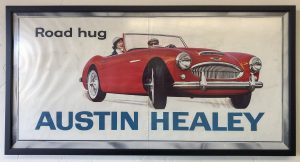
That’s a tri-carb depicted so we can date it as probably 1962. There’s no publication number or other data visible, so most likely it is something produced by a US distributor.
And dig those whitewalls! Pure style.
You’ve all heard the joke about the solution to a tough job being “a bigger hammer.” Well, in dismantling the RHD BN2 for the paint shop we ran into a situation where we needed a bigger wrench. Er, spanner. Now Kent has a tremendous collection of tools, but I’ll bet you never thought you’d see an adjustable spanner quite in this league.
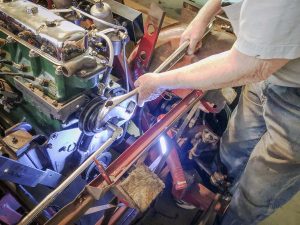
This is not a picture posed for humorous effect. It really was what we needed and what we used to remove the water pump, and it worked like a charm. You just never know when those fine adjustments tools will come in handy.















